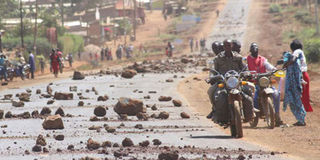Uhuru should dismiss Boinnet over student leader’s killing by police

Meru University of Science and Technology students litter Maua road with stones on February 27, 2018, during protests over the killing of their student leader Evans Njoroge by a police officer. PHOTO | PHOEBE OKALL | NATION MEDIA GROUP
What you need to know:
- President Kenyatta, whose reign is increasingly drawing comparisons with Mr Moi’s, should redeem his administration’s human rights image.
- Mr Kenyatta needs to fire Inspector-General of Police Joseph Boinnet, whose tenure at Vigilance House has coincided with an escalation of brutality.
The killing of Meru University of Science and Technology student leader Evans Njoroge by police last week harks back to the dark period 22 years ago when it was particularly dangerous to be in a public university campus.
A wave of student unrest in 1996 often drew brutal force from the police.
At Egerton University, where I was in my third year of study, confrontations between comrades and the anti-riot police would at times last a week.
The protests came at a great academic cost to students, with the subsequent lengthy university closures causing my class to graduate a year behind schedule.
But the pain of academic loss was nowhere near that of the deaths of students from police bullets.
PROTESTS
Festus Okonyo Etaba was part of a group returning one December morning from the nearby Ngongogeri Forest, where they had escaped a door-to-door police clampdown at the Njoro campus’ hostels the previous night, when he was hit by a bullet.
Etaba, the son of a military officer based at Lanet Barracks in Nakuru, was only in his first year of study.
His killing sparked a wave of protests in other public universities, which ended with yet more students’ blood spilled.
Two Kenyatta University students, Kenneth Makokha and Eric Kamundi, died from bullets when an anti-riot police squad moved in to break up a demonstration held there to protest the killing of Etaba.
The three deaths capped a murderous year on campus that began with the kidnap and torture of the University of Nairobi student leader, Solomon Muruli, by people believed to be police officers.
Muruli would be murdered in a bizarre fire in his Kikuyu Campus room on February 1997.
JUSTICE
There are no prizes for guessing if the murdered students’ families got justice.
But for all his regime’s poor human rights record, President Daniel arap Moi was fairly responsive to the public outrage over the campus killings.
Police Commissioner Shedrach Kiruki lost his job around the same time, sending a message that the police bosses would be held accountable for operational cock-ups and rights abuses involving their juniors.
Mr Kiruki’s exit also added momentum to the clamour for police reforms spearheaded by the civil society.
A public inquest was ordered in Etaba’s case and 11 police officers were charged with the murder of the KU students.
HUMAN RIGHTS
Faced with similar public outrage over the latest campus murder, President Uhuru Kenyatta, whose reign is increasingly drawing comparisons with Mr Moi’s, should borrow a leaf from his mentor and redeem his administration’s human rights image.
For a start, Mr Kenyatta needs to fire Inspector-General of Police Joseph Boinnet, whose tenure at Vigilance House has coincided with an escalation of brutality.
A new report by Human Rights Watch shows that police killed at least 23 people during and after the repeat presidential election last October.
The murder of Evans Njoroge, the Meru University of Science and Technology student leader, shouldn’t be just another statistic.
[email protected] @otienootieno





